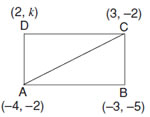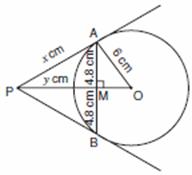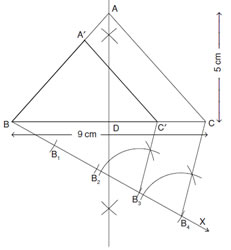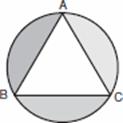SOCIAL SCIENCE - 2009
Comptt- Set-III
Outside Delhi.
Q1. Why did the Roman Catholic Church impose controls over publishers and book-sellers?
1
Ans. Print and popular religious literature encouraged many different individual interpretations of faith even among little educated working people. Manocchio, a miller in Italy, reinterpreted the message of the Bible and formulated a view of God and Creation. Enraged by this and troubled by such effects of popular readings and questionings of faith, the Roman Catholic Church imposed controls over publishers and booksellers.
Or
Why were novels serialized in magazines in the 19th century? Give one reason. 1
Ans. Novels were serialised in magazines in the 19th century as magazines were attractive. They were illustrated and cheap and serialisation allowed readers to relish the suspense, discuss the characters of the novels and literally live for weeks with their stories.
Q. 2. State one reason for the need to conserve the water resources. 1
Ans. Water is indispensbale for the survival of human beings. We need water:-
(i) To ensure food security.
(ii) For continuation of our livelihoods and productive activities of the nation.
(iii) To prevent degradation of our natural eco-system. (any one)
Q. 3. Give the difference between mineral and ore. 1
Ans. A mineral is a homogeneous, naturally occurring substance with a definable internal structure. Minerals have physical and chemical properties by which they are identified. Ore is an accumulation of any mineral mixed with other elements. Minerals are usually found in ‘ores’.
Q. 4. What are State highways? 1 Ans. Roads linking a State capital with different district headquarters are known as State Highways. These roads are constructed and maintained by the Public Works Departments (PWD) in States and Union Territories.
Q. 5. Name the Australian athlete who supported Tommie Smith and John Carlos in the 1968 Olympics. 1
Ans. Peter Norman.
Q. 6. Mention any one reason for the declining child sex ratio in India. 1
Ans. Parents in many parts of India prefer to have sons and find ways to have the girl-child aborted before she is born. Such sex-selective abortions have led to a decline in child sex ratio (number of girl children per thousand boys) in India.
Q. 7. Define the term ‘democracy reform’. 1
Ans. All the suggestions or proposals about overcoming various challenges to democracy are called ‘democracy reforms’ or ‘democratic reforms’.
Q. 8. Why is it that income by itself is not a completely adequate indicator of material goods and services, that citizens are able to use? Give one example. 1
Ans. Income by itself is not a completely adequate indicator of material goods and services, that citizens are able to use. Quality of life also depends on non-material things like equal treatment, freedom, security, respect of others etc. For example, a person may be in a job which gives him a high pay, but there is no security in his job and leaves him with no time for family. So, in this case, high income is not important as the person has no sense of security and freedom.
Q. 9. Amongst Kerala, Bihar and Punjab, which one has highest per capita income? 1
Ans. Punjab.
Q. 10. What does gross enrolment ratio for three levels mean? 1
Ans. Gross Enrolment Ratio for three levels means enrolment ratio for primary school, secondary school and higher education beyond secondary school.
Q. 11. Explain the reasons for Gandhiji’s decision to launch a nation-wide Satyagraha against the Rowlatt Act 1919. 3
Ans. Textbook Questions,
Q. 12. Explain the reasons for relaunching the Civil Disobedience Movement by Gandhiji. 3
Ans. Gandhiji entered into a pact with Viceroy Irwin on 5th March 1931. By this Gandhi-Irwin Pact, Gandhiji consented to participate in a Second Round Table Conference and the government agreed to release the political prisoners. In December, 1931, Gandhiji went to London for the Conference but the negotiations failed and he returned disappointed.
On returning, he realised that the government had begun a new cycle of repression, Ghaffar Khan and Jawaharlal Nehru were both in jail, the Congress had been declared illegal, and a series of measures had been imposed to prevent meetings, demonstrations and boycotts.
Thus, with great apprehension, Gandhiji relaunched the Civil Disobedience Movement.
Note : - Below are given three groups - A, B and C for questions number 13 and 14. Select any one group for answering these two questions.
Group A
Q. 13. Explain how Europeans overcame the problem of shortage of labour willing to work for wages in Africa. 3×1=3
Ans. European employers used many methods to recruit and retain labour in Africa. They overcame the problem of shortage of labour in the following ways:
(i) Heavy taxes were imposed which could be paid only by working for wages on plantations and mines. (ii) Inheritance Laws were changed so that peasants were displaced from land: only one member of a family was allowed to inherit land, as a result of which the others were pushed into the labour market.
(iii) Mine workers were confined in compounds and were not allowed to move about freely.
Q. 14. Explain the circumstances in the 17th and 18th centuries which made the merchants of Europe shift their interest from towns to countryside. 3×1=3
Ans. In the seventeenth and eighteenth centuries, merchants from towns in Europe began moving to the countryside, supplying money to peasants and artisans, persuading them to produce for an international market. Reasons:
Group B
Q. 13. Explain the impact of the Great Depression on U.S. 3×1=3
Ans. See Q. 6(iii), Additional Questions, Chapter 4. [Page H-34
Q. 14. Explain the land reclamation process in Bombay (Mumbai). 3×1=3
Ans. The need for additional commercial space in the mid-nineteenth century led to the formulation of several plans, both by the government and private companies, for the reclamation of more land from the sea. In 1864, the Back Bay Reclamation Company won the right to reclaim the western foreshore from the tip of Malabar Hill to the end of Colaba. Reclamation also often meant the levelling of hills around Bombay. By the 1870s, the city of Bombay (Mumbai) had expanded to about 22 square miles.
As population continued to increase rapidly in the early twentieth century, every bit of available area was built over and new areas were reclaimed from the sea.
The Bombay Port Trust built a dry dock between 1914 and 1918, and used the excavated earth to create the 22-acre Ballard Estate. Subsequently, the famous Marine Drive was also developed.
Group C
Q. 13. Explain three reasons why there was an increasing concern to house the London poor. 3×1=3
Q. 14. Explain any three effects of the First World War on the industrial growth in India. 3×1=3
Ans.
Q. 15. Explain the significance of newspapers and journals developed from the early 18th century. 3
Ans. By the close of the eighteenth century, a number of newspapers and journals appeared in print.
a). Not just the English people, the Indians too began to publish Indian newspapers.
b). The first newspaper to come out was the weekly Bengal Gazette, brought out by Gangadhar Bhattacharya.
c). Printed tracts and newspapers not only spread new ideas, but they also shaped the nature of debate. A wider public could now participate in public discussions and express their views
d). There were intense controversies between the social and religious reformers and Hindu orthodoxy over matters like widow immolation, monotheism, Brahmanical priesthood and idolatory. So that these ideas and thoughts could reach a wider audience, newspapers were printed in the spoken language of ordinary people.
e). Rammohun Roy published the Sambad Kaumudi from 1821 and the Hindu orthodoxy commissioned the Samachar Chandrika to oppose his opinions.
f). Two Persian newspapers, Jam-i-Jahan Nama and Shamsul Akhbar were also published.
g). Newspapers and journals not only helped the publication of conflicting opinions but also connected people and communities in different parts of India. Newspapers conveyed news from one place to another, creating Pan-Indian identities.
Or
How did the women novel writers express their feelings through the novels during the 19th century.
Ans. a). With the middle classes becoming more prosperous, the women got more leisure to read as well as write. Novels began exploring the world of women their emotions and identities, their experiences and problems.
b). Many novels were written about domestic life, a theme about which women spoke with utmost authority. Women drew upon their own personal experiences and wrote about family life and earned public recognition.
c). Novelists like Jane Austen wrote about women in the genteel rural society in Britain, where women were encouraged to look for ‘good’ marriages and find wealthy husbands.
d). Women novelists also wrote about women who broke established norms of society before adjusting to them. Women readers associated with such characters and sympathised with their rebellious actions. e). Charlotte Bronte’s ‘Jane Eyre’, published in 1847, is one such novel in which young Jane is an independent and assertive character.
Q. 16. Explain any three conditions that favour the growth of railways in the northern plains of India. 3×1=3
Ans.
Q. 17. Study the table given below and answer the questions that follow .
| Type of regimes and countries | Growth Rate |
| All democratic regimes | 3.95 |
| All dictatorial regimes | 4.42 |
| Poor countries under dictatorship | 4.34 |
| Poor countries under democracy | 4.28 |
(17.1) What is the rate of economic growth of all dictatorial regimes?
(17.2) Mention any two reasons why economic growth rate alone cannot be a reason to reject democracy. 1+2=3
Ans. (17.1) The economic growth rate of all dictatorial regimes is 4.42%.
(17.2) The inability of a democracy to achieve higher economic growth rate is not reason enough to reject democracy. This is because:
(a) Economic development depends on several factors such as a country’s population size, global situation, cooperation from other countries, economic priorities adopted by the country, etc. and not just democratic principles alone.
(b) A democracy has several other positive outcomes which make it a better option than dictatorships. A democracy is a people’s own government. Decisions in a democracy are acceptable to the people and are more effective.
Q. 18. Analyse with three suitable examples why rules and regulations are required for the protection of consumers in the marketplace. 3×1=3
Ans. Rules and regulations are required for the protection of consumers in the market place.
— The consumers often find themselves in a weak position as the seller always tries to shift the responsibility on to the consumer
— Rules and regulations are necessary to prevent unfair trade practices such as overcharging, selling commodities in smaller quantities than shown on the package, hoarding, black-marketing, adulteration of food and edible oils, charging more than the actual price, weighing less, selling defective goods, etc. Rules and regulations give support to consumers.
— Till recently there was no authority or organisation where a consumer could lodge a complaint. All a buyer could do was avoid buying the brand for which he was cheated. Rules and Regulations and the Consumer movement today are a social force to safeguard the rights of consumers.
Q. 19. “Equality before law did not necessarily stand for universal suffrage in France after the revolution.” Explain with suitable examples. 4
Ans. “Equality before law did not necessarily stand for universal suffrage in France after the revolution.” Universal suffrage or universal right to vote was never granted. In revolutionary France, as part of the first political experiment in liberal democracy, the right to vote and get elected was granted exclusively to property-owning men. Men without property and all women did not get political rights. Only briefly under the Jacobins all the adult males enjoyed suffrage. The Napoleonic Code also went back to limited suffrage and reduced women to the status of a minor, subject to the authority of fathers and husbands. Throughout the nineteenth and early twentieth centuries, women and non-propertied men organised opposition movements demanding equal political rights.
Or
Explain the effects of Vietnam war on U.S. and Vietnam. 2+2=4
Ans. The consequences of Vietnam War were disastrous for both Vietnam and US.
Effects on Vietnam. The war brought with it death and destruction to the people of Vietnam and to its environment. The US entry into the war led to a period of brutal struggle. Thousands of US troops arrived equiped with heavy weapons and tanks backed by most powerful bombers of the time—the B 52s. The widespread attacks and use of chemical weapons—Napalm, Agent Orange and Phosphorous bombs destroyed many villages and decimated jungles. Civilians also died in large numbers.
Effect on US.
(i) Most of the people in the US were critical of the Government’s policy of war. When the youths were drafted (forced recruitment) for the war, the anger grew. Compulsory service in the armed forces, however, could be waived for university graduates. This meant many of those sent to fight did not belong to the priviledged elite, but were minorities and children of working class families which created a lot of resentment.
(ii) US media played a major role in both supporting and criticising the war. Hollywood made films in support of the war. (Example: John Wayne’s Green Berets; 1968). The film was taken as a war propaganda film, responsible for motivating many young men to die in the war. Other films were more critical. (Example: John Ford Coppala’s Apocalypse Now 1979 reflected the moral confusion that the war causedin the US).
Q. 20. Describe any four factors responsible for soil formation. 4×1=4
Ans. Soil is a living system. It takes millions of years to form soil up to a few centimeters in depth. Factors responsible for soil formation are:
(i) Parent rock or bed rock on which the soils are formed, disintegrate and decompose under the process of weathering and erosion.
(ii) Climate: It determines the rate of weathering.
(iii) Relief, vegetation, other forms of life and time are other important factors in the formation of soils.
(iv) Various forces of nature such as change in temperature, actions of running water, wind and glaciers, activities of decomposers etc. also contribute to the formation of soil.
(v) Chemical and organic changes which take place in soil, also play a role in its formation.
Q. 21. Explain any four efforts made by the Government to improve and modernise Indian agriculture. 4×1=4
Ans.
Q. 22. “The challenge of sustainable development requires integration of economic development with environmental concerns.” Support the statement by giving four measures that can be taken by the industries to protect the environment. 4×1=4.
Ans. Measures that can be taken by industries to protect the environment are as follows:
(i) Reducing the use of water for processing by reusing and recycling at various stages.
(ii) Rain water harvesting to meet the growing need for water.
(iii) Proper treatment of hot water and effluents before discharging them into rivers.
(iv) There should be careful planning during siting of industries, better designing of industrial equipment and better operation of the equipment.
(v) Oil or gas should be used instead of coal to reduce smoke.
(vi) Generators should be fitted with silencers.
(vii) Aerosol emissions can be reduced by the use of separators, scrubbers, filters, precipitators, etc.
(viii) Shifting of industries away from the cities. (any four).
. 23. Explain any four amendments made in the Constitution as a major step towards decentralization, in order to make the third tier of democracy more powerful and effective. 4×1=4
Ans.
Q. 24. Taking the example of Netherlands and Northern Ireland, explain the effects of overlapping and cross cutting social differences. 2+2=4
Ans.
Q. 25. “Very often political parties do not seem to offer meaningful choice to voters.” Support the statement with examples. 4
Ans. A major challenge faced by political parties is that very often, the parties do not seem to offer meaningful choices to the voters. In recent years, there has been a decline in ideological differences among parties in most parts of the world. For example, The Labour Party and Conservative Party in Britain are not very different from each other. They agree on more fundamental aspects but differ only in details on how policies are to be framed and implemented. Even in India, the differences among all the major political parties on the economic policies have reduced. Citizens who want different policies have little option available to them. Sometimes citizens who want to elect different leaders are left with no choice because the same set of leaders keep shifting from one party to another.
Q. 26. Describe certain activities of public interest on which the Government has to focus on priority basis. 4
Ans. Activities of public interest on which the government needs to focus on a priority basis:
(i) Education. The government must provide adequate education facilities in all rural and urban areas. The government must necessarily focus on education for girls so that all girls are able to acquire atleast secondary level schooling. Running proper schools and providing quality education, particularly elementary education, is the duty of the government.
(ii) Health and Nutrition.
(a) Basic health care facilities are a must for all. Establishment of government hospitals, clinics and dispensaries especially in the rural areas to provide subsidized and unadulterated medicines to the poorer sections of society.
(b) An effective Public Distribution System—proper functioning of ration shops and equitable distribution of foodgrains in very essential.
(iii) Transporation. A well developed public transport system to make it easy for general public to commute.
(iv) Electricity. It is the duty of the government to provide electricity and water at reasonable rates to the common man and prevent him from exploitation by private companies.
Q. 27. Study the graph carefully and answer the questions that follow:
Ans. (27.1) Formal sources: Commercial Banks and Co-operative Societies. Informal sources: Moneylenders, Relatives and friends.
(27.2) Two reasons why co-operative societies and banks need to lend more:
(i) Formal sources of credit such as banks and co-operative societies function as per the rules and guidelines laid down by the Reserve Bank of India. They maintain stipulated cash balance and cash reserves. Their operations are supervised by the Reserve Bank and they cannot charge any rate of interest from the borrowers according to their whims. Banks provide affordable credit at reasonable rates of interest.
(ii) There is no organisation that supervises the credit activities of lenders in the informal sector. They lend at whatever rate they choose and use unfair means to get their money back. Thus, it is necessary that banks and co-operatives increase their lending, especially in rural areas.
The following question is for the Blind Candidates only, in lieu of Q. No. 27.
(27.1) What role does the Reserve Bank of India (RBI) play in supervising the functions of formal sector of loans? Give any two points.
(27.2) Explain any two demerits of informal sector of loans. 2+2=4
Ans.
(27.2) Demerits of informal sector of loans:
(a) They charge very high rates of interest.
(b) They use unfair means to get their money back.
Q. 28. “Rapid improvement in technologies has been a major factor that has stimulated the globalization process.” Support the statement with suitable examples. 4×1=4
Ans. Improvement in technology has played a major role in stimulating the globalisation process:
1. Technology. Rapid improvement in technology has contributed greatly towards globalisation. Advanced technology in transport system has helped in faster delivery of goods across long distances at lower costs.
2. Development of information and communication technology also has helped a great deal. Telecommunication facilities—telegraph, telephone (including mobile phones), fax, e-mail etc. are now used to contact one another quickly around the world, access information instantly and communicate from remote areas. Teleconferences help in saving frequent long trips across the globe.
3. Information technology has also played an important role in spreading out production of services across countries. Orders are placed through internet, designing is done on computers, even payment for designing and printing can be arranged through the internet. Internet allows us to send instant electronic mail (e-mail)
Q. 29. Six features with serial numbers 1 to 6 are marked in the given political outline map of India. Identify these features with the help of the following information and write their correct names on the lines marked in the map: 6×1=6
(1) Main centre of overseas trade during seventeenth century
(2) A large scale indus-trial region of India in 1931
(3) A type of soil
(4) A major State producing groundnut
(5) Area where bauxite mine is located
(6) An International airport.
Or
Locate and label the following items with appropriate symbols on the given political outline map of India:
6×1=6
(i) A place where the Congress session was held in 1927.
(ii) A place where ‘no tax campaign’ was carried out.
(iii) An iron and steel plant in Chhattisgarh.
(iv) A nuclear plant in Uttar Pradesh.
(v) A software technology park in Orissa
(vi) A major sea port in Kerala.
Note: The following question is for the Blind Candidates only, in lieu of Q. No. 29. (29.1) Name the place that witnessed a violent incident which forced Mahatma Gandhi to withdraw the Non-Cooperation Movement. (29.2) Name the Congress session where the resolution of Poorna Swaraj was taken. (29.3) Name the type of soil found in Uttar Pradesh. (29.4) Name the major sea port in Goa. (29.5) In which State is Balaghat manganese mine located? (29.6) Name the major sugarcane producing State of India. 6×1=6
Ans. (29.1) Chauri Chaura in Uttar Pradesh.
(29.2) The Lahore Session of the Indian National Congress in 1929.
(29.3) Alluvial soil.
(29.4) Marmagao.
(29.5) Madhya Pradesh
(29.6) Uttar Pradesh















 2(y – 5) + x(5 – 1) + 7(1 – y) = 0
2(y – 5) + x(5 – 1) + 7(1 – y) = 0





 x – y + 3 = 0, is consistent. Also find the coordinates of the points where the graphs of the equations meet the y-axis.
x – y + 3 = 0, is consistent. Also find the coordinates of the points where the graphs of the equations meet the y-axis.

 Given pair of equations is not consistent, i.e., inconsistent.
Given pair of equations is not consistent, i.e., inconsistent. , if 2 is added to both numerator and denominator. If 3 is added to both
, if 2 is added to both numerator and denominator. If 3 is added to both .
. 


 = 24
= 24  term
term  term=13th term
term=13th term show that
show that






 …..[
…..[





 ABC)
ABC) + (-3)[ -2 – (-2 )] + 3[ -2-(-5)] (-4 , -2)
+ (-3)[ -2 – (-2 )] + 3[ -2-(-5)] (-4 , -2) -3 (-2+2 + 3 (-2 + 5) ]
-3 (-2+2 + 3 (-2 + 5) ] -3(0) + 3 (3 ) ]
-3(0) + 3 (3 ) ]
 + ar (
+ ar ( =
=
 [-4(-2-k) + 3 (k- (-2)) + 2(-2-(-2))] =
[-4(-2-k) + 3 (k- (-2)) + 2(-2-(-2))] = 


 APB
APB  AB and therefore, OP bisects AB which gives
AB and therefore, OP bisects AB which gives






 =+8 cm
=+8 cm
 = 1.73,
= 1.73, 

 =1200
=1200



























